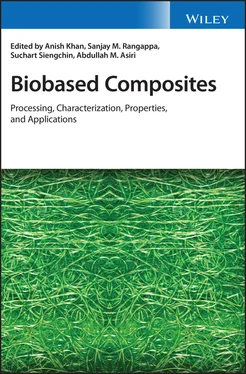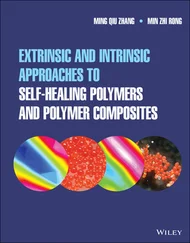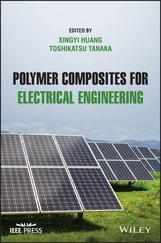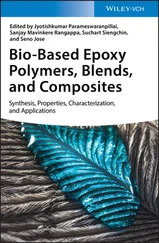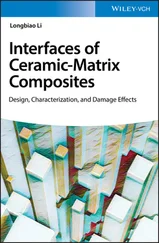Biobased Composites
Здесь есть возможность читать онлайн «Biobased Composites» — ознакомительный отрывок электронной книги совершенно бесплатно, а после прочтения отрывка купить полную версию. В некоторых случаях можно слушать аудио, скачать через торрент в формате fb2 и присутствует краткое содержание. Жанр: unrecognised, на английском языке. Описание произведения, (предисловие) а так же отзывы посетителей доступны на портале библиотеки ЛибКат.
- Название:Biobased Composites
- Автор:
- Жанр:
- Год:неизвестен
- ISBN:нет данных
- Рейтинг книги:4 / 5. Голосов: 1
-
Избранное:Добавить в избранное
- Отзывы:
-
Ваша оценка:
- 80
- 1
- 2
- 3
- 4
- 5
Biobased Composites: краткое содержание, описание и аннотация
Предлагаем к чтению аннотацию, описание, краткое содержание или предисловие (зависит от того, что написал сам автор книги «Biobased Composites»). Если вы не нашли необходимую информацию о книге — напишите в комментариях, мы постараемся отыскать её.
Biobased Composites: Processing, Characterization, Properties, and Applications
Biobased Composites
Biobased Composites — читать онлайн ознакомительный отрывок
Ниже представлен текст книги, разбитый по страницам. Система сохранения места последней прочитанной страницы, позволяет с удобством читать онлайн бесплатно книгу «Biobased Composites», без необходимости каждый раз заново искать на чём Вы остановились. Поставьте закладку, и сможете в любой момент перейти на страницу, на которой закончили чтение.
Интервал:
Закладка:
Collecting as much information as possible on the inputs and outputs at each stage of the product life.
Impact analysis
Studying the environmental impacts of the inputs and the outputs at each stage of the product life.
Interpretation
Using the data and information collected, the product life cycle will be improved, and the environmental impact will be reduced.
The LCA is performed by passing over these phases frequently in an iterative manner.
1.7 Conclusions
Improving the different features of the biobased composites is directly reflected by the progress achieved in the evaluation and selection processes of their constituents, in addition to the preparation and treatment of fiber–polymers. Therefore, it is very important to build robust and efficient selection methods to improve the performance of the biocomposites, and to reduce the negative environmental effects. Doing this would lead to more informed decisions and save efforts and time. Application of such methods can be expanded to include more characteristics and more potential types of the composites' constituents to derive new biomaterials with optimal performance for a greener future.
References
1 1 AL‐Oqla, F.M., Sapuan, M.S., Ishak, M.R., and Nuraini, A.A. (2015). Selecting natural fibers for bio‐based materials with conflicting criteria. American Journal of Applied Sciences 12 (1): 64–71.
2 2 AL‐Oqla, F.M. and Sapuan, S. (2015). Polymer selection approach for commonly and uncommonly used natural fibers under uncertainty environments. JOM 67 (10): 2450–2463.
3 3 Al‐Oqla, F.M. and Sapuan, S. (2018). Natural fiber composites. In: Kenaf Fibers and Composites, vol. 1 (eds. S.M. Sapuan, J. Sahari, M.R. Ishak and M.L. Sanyang). CRC Press.
4 4 AL‐Oqla, F.M. (2017). Investigating the mechanical performance deterioration of Mediterranean cellulosic cypress and pine/polyethylene composites. Cellulose 24 (6): 2523–2530.
5 5 Al‐Oqla, F.M. and El‐Shekeil, Y. (2019). Investigating and predicting the performance deteriorations and trends of polyurethane bio‐composites for more realistic sustainable design possibilities. Journal of Cleaner Production 222: 865–870.
6 6 Alaaeddin, M., Sapuan, S., Zuhri, M. et al. (2018). Properties and common industrial applications of polyvinyl fluoride (PVF) and polyvinylidene fluoride (PVDF). In: IOP Conference Series: Materials Science and Engineering, vol. 409, 012021. IOP Publishing.
7 7 Al‐Oqla, F.M., Hayajneh, M.T., and Fares, O. (2019). Investigating the mechanical thermal and polymer interfacial characteristics of Jordanian lignocellulosic fibers to demonstrate their capabilities for sustainable green materials. Journal of Cleaner Production 241: 118256.
8 8 AL‐Oqla, F.M. and Omari, M.A. (2017). Sustainable biocomposites: challenges, potential and barriers for development. In: Green Biocomposites: Manufacturing and Properties (eds. M. Jawaid, S.M. Sapuan and O.Y. Alothman), 13–29. Cham: Springer.
9 9 AL‐Oqla, F.M. and Salit, M.S. (2017). Material selection of natural fiber composites using the analytical hierarchy process. In: Materials Selection for Natural Fiber Composites, vol. 1, 169–234. Cambridge, USA: Woodhead Publishing, Elsevier.
10 10 AL‐Oqla, F.M., Sapuan, M.S., Ishak, M.R., and Aziz, N.A. (2014). Combined multi‐criteria evaluation stage technique as an agro waste evaluation indicator for polymeric composites: date palm fibers as a case study. BioResources 9 (3): 4608–4621. https://doi.org/10.15376/biores.9.3.4608‐4621.
11 11 AL‐Oqla, F.M., Sapuan, M.S., Ishak, M.R., and Nuraini, A.A. (2015). Decision making model for optimal reinforcement condition of natural fiber composites. Fibers and Polymers 16 (1): 153–163.
12 12 AL‐Oqla, F.M. and Sapuan, S. (2018). Investigating the inherent characteristic/performance deterioration interactions of natural fibers in bio‐composites for better utilization of resources. Journal of Polymers and the Environment 26 (3): 1290–1296.
13 13 Al‐Oqla, F.M., Sapuan, S., Anwer, T. et al. (2015). Natural fiber reinforced conductive polymer composites as functional materials: a review. Synthetic Metals 206: 42–54.
14 14 Al‐Oqla, F.M., Sapuan, S., and Fares, O. (2018). Electrical‐based applications of natural fiber vinyl polymer composites. In: Natural Fibre Reinforced Vinyl Ester and Vinyl Polymer Composites, 349–367. Elsevier.
15 15 AL‐Oqla, F.M., Sapuan, S., Ishak, M., and Nuraini, A. (2015). A model for evaluating and determining the most appropriate polymer matrix type for natural fiber composites. International Journal of Polymer Analysis and Characterization 20: 191–205. (just‐accepted).
16 16 AL‐Oqla, F.M., Sapuan, S., Ishak, M., and Nuraini, A. (2015). Predicting the potential of agro waste fibers for sustainable automotive industry using a decision making model. Computers and Electronics in Agriculture 113: 116–127.
17 17 AL‐Oqla, F.M., Sapuan, S., Ishak, M., and Nuraini, A. (2016). A decision‐making model for selecting the most appropriate natural fiber – polypropylene‐based composites for automotive applications. Journal of Composite Materials 50 (4): 543–556.
18 18 AL‐Oqla, F.M., Sapuan, S., Ishak, M., and Nuraini, A. (2014). A novel evaluation tool for enhancing the selection of natural fibers for polymeric composites based on fiber moisture content criterion. BioResources 10 (1): 299–312.
19 19 AL‐Oqla, F.M., Sapuan, S., and Jawaid, M. (2016). Integrated mechanical–economic – environmental quality of performance for natural fibers for polymeric‐based composite materials. Journal of Natural Fibers 13 (6): 651–659.
20 20 AL‐Oqla, F.M. and Sapuan, S. (2014). Natural fiber reinforced polymer composites in industrial applications: feasibility of date palm fibers for sustainable automotive industry. Journal of Cleaner Production 66: 347–354. https://doi.org/10.1016/j.jclepro.2013.10.050.
21 21 Iannotti, G., Fair, N., Tempesta, M. et al. (2018). Studies on the environmental degradation of starch‐based plastics. In: Degradable Materials, 425–446. CRC Press.
22 22 Ibrahim, H., Farag, M., Megahed, H., and Mehanny, S. (2014). Characteristics of starch‐based biodegradable composites reinforced with date palm and flax fibers. Carbohydrate Polymers 101: 11–19.
23 23 Ilyas, R., Sapuan, S., Ishak, M., and Zainudin, E. (2018). Development and characterization of sugar palm nanocrystalline cellulose reinforced sugar palm starch bionanocomposites. Carbohydrate Polymers 202: 186–202.
24 24 AL‐Oqla, F.M., Almagableh, A., and Omari, M.A. (2017). Design and Fabrication of Green Biocomposites Green Biocomposites, 45–67. Cham: Springer.
25 25 AL‐Oqla, F.M., Alothman, O.Y., Jawaid, M. et al. (2014). Processing and properties of date palm fibers and its composites. In: Biomass and Bioenergy, 1–25. Cham: Springer.
26 26 Al‐Oqla, F.M. and Omar, A.A. (2015). An expert‐based model for selecting the most suitable substrate material type for antenna circuits. International Journal of Electronics 102 (6): 1044–1055.
27 27 AL‐Oqla, F.M., Omar, A.A., and Fares, O. (2018). Evaluating sustainable energy harvesting systems for human implantable sensors. International Journal of Electronics 105 (3): 504–517.
28 28 Alaaeddin, M., Sapuan, S., Zuhri, M. et al. (2019). Lightweight and durable PVDF–SSPF composites for photovoltaics backsheet applications: thermal, optical and technical properties. Materials 12 (13): 2104.
29 29 Almagableh, A., Al‐Oqla, F.M., and Omari, M.A. (2017). Predicting the effect of nano‐structural parameters on the elastic properties of carbon nanotube‐polymeric based composites. International Journal of Performability Engineering 13 (1): 73.
Читать дальшеИнтервал:
Закладка:
Похожие книги на «Biobased Composites»
Представляем Вашему вниманию похожие книги на «Biobased Composites» списком для выбора. Мы отобрали схожую по названию и смыслу литературу в надежде предоставить читателям больше вариантов отыскать новые, интересные, ещё непрочитанные произведения.
Обсуждение, отзывы о книге «Biobased Composites» и просто собственные мнения читателей. Оставьте ваши комментарии, напишите, что Вы думаете о произведении, его смысле или главных героях. Укажите что конкретно понравилось, а что нет, и почему Вы так считаете.
